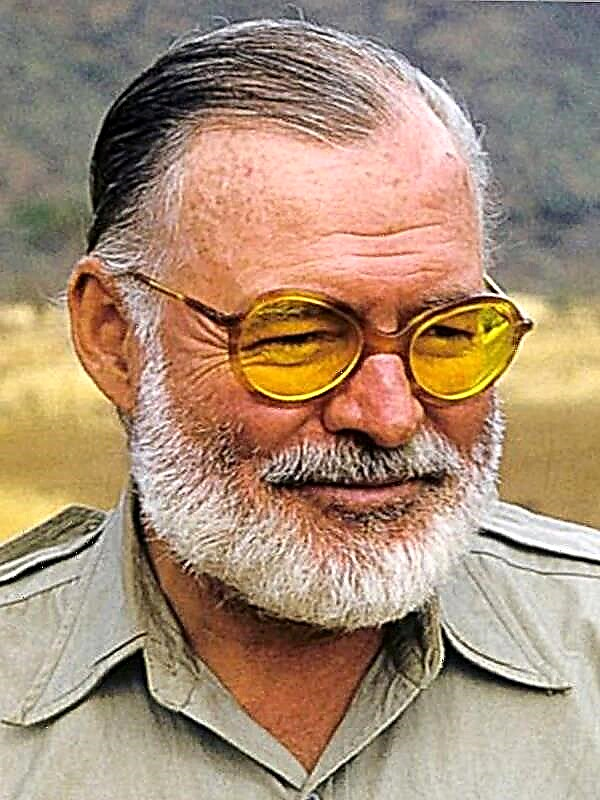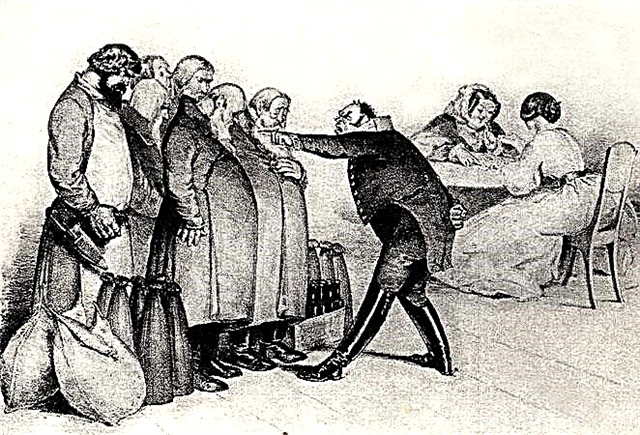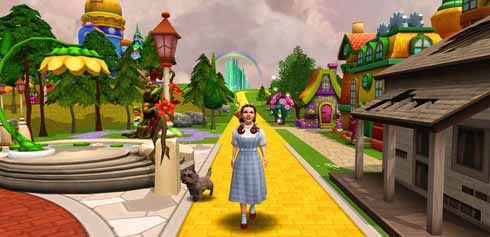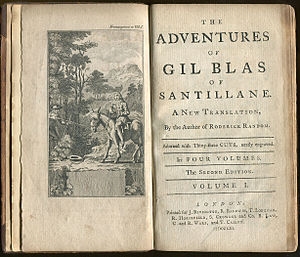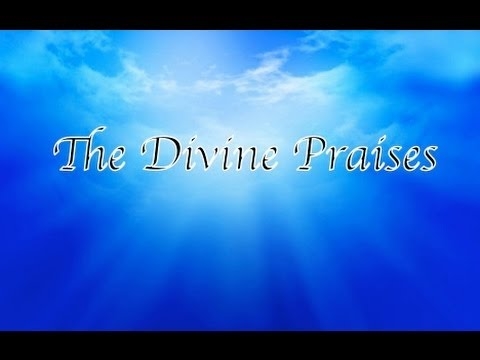Sergei Yesenin (1895-1925) is a great creator, whose soulful poems about the Russian soul and the “voice of the people” have long become classics of the early twentieth century. It is not without reason that they call him “subtle lyrics” and “landscape master” - this can be seen by reading any of his works. But the work of the "peasant poet" is so multifaceted that two words are not enough to characterize it. It is necessary to evaluate all the motives, topics and stages of his journey in order to understand the sincerity and depth of each line.
History of success
September 21, 1895 in the village of Konstantinovo in the Ryazan region (province), the Russian poet Sergei Alexandrovich Yesenin was born. The parents of the "yellow-haired" boy with blue eyes - Tatyana Fedorovna and Alexander Nikitich - were of peasant origin. It was customary in their midst to marry young girls against their will, and such marriages usually broke up. So it happened in the family of Sergei, who had 2 sisters - Catherine (1905-1977) and Alexander (1911-1981).
Almost immediately after the wedding, Yesenin’s father, Alexander, returned to Moscow to earn money: he worked there in a butcher’s shop, while his wife, Tatyana, returned to her “father’s house,” where little Sergei spent most of his childhood. There was not enough money in the family, despite the work of her father, and Yesenin's mother left for Ryazan. It was then that grandmother and grandfather took up the upbringing of the child. Titov Fedor Andreevich - Sergei’s grandfather - was an expert on church books, while the grandmother of the future poet, Natalya Evtikhievna, knew a lot of folk songs and poems. Such a “family tandem” prompted young Seryozha to write his first future prose works, because already in his 5 years old Yesenin learned to read, and at 8 he tried to write his first poems.
In 1904, Yesenin went to the Konstantinovsky Zemstvo School, where after receiving a "diploma" with honors (1909) he decided to enroll in a parish second-class teacher's school. A young man who misses his relatives only came to Konstantinovo during the holidays. It was then that he began to write his first poems: “The Coming of Spring”, “Winter” and “Autumn” - the approximate date of creation is 1910. After 2 years, in 1912, Yesenin receives a diploma in "literacy teacher" and decides to leave home for Moscow.
Work in the meat shop of Krylov, of course, was not the subject of the dream of young Yesenin, therefore, after a quarrel with his father, under whose supervision he worked, he decided to leave to work at the printing house of I.D.Sytin. Why has this position become one of the most important “steps” on the path to the fulfillment of his desires? It was there that he met his first common-law wife, Anna Izryadova, and opened to himself access to the literary and musical circle.
Entering the Shanyavsky Moscow City People’s University at the Faculty of History and Philosophy in 1913, Yesenin soon left the institute and devoted himself entirely to writing poems. A year later, he began to be published in the journal Mirok (Birch (1914)), and a few months later the Bolshevik newspaper The Way of Truth published several more of his poems. The year 1915 became especially significant as a judge of a Russian poet - he met A. Blok, S. Gorodetsky and N. Gumilyov. In October of the same year, the journal Protalinka published Mother's Prayer, dedicated to the First World War.
Sergei Yesenin was called up for war, but thanks to his influential friends, he was assigned to the Tsarskoye Selo military-sanitary train No. 143 of Her Imperial Majesty Empress Alexandra Fedorovna - it was there that he began to devote himself even more to the “spirit of the times” and to attend literary circles. Subsequently, the first literary article “Yaroslavny Cry” was published in the journal “Women's Life”.
Omitting the details of the life of the great poet in Moscow, we can also say that his “revolutionary mood” and the attempt to fight for “Russian truth” played a cruel joke with him. Yesenin writes several small poems - “Jordanian Pigeon”, “Inonia”, “Sky Drummer” - which were completely imbued with a sense of a change in life, but this did not change his status and made him famous. His freedom-loving impulses only attracted the gendarmes to his speeches. Significantly on his fate was influenced by a completely different circumstance - acquaintance with Anatoly Mariengof and flirting with new modernist trends. Yesenin's Imaginism is a description of the patriarchal way of life of the “poor peasants” who have lost the ability to fight for their own independence (The Keys of Mary 1919). However, the shocking village boy in a shirt, belted with a red sash, begins to annoy the public. And a year later, in his work, the image of a drunkard, a bully and a brawler appears, which is surrounded by "rabble" ("Confession of a bully"). This motive was met with approval and enthusiasm by the residents of the capital. The poet realized where the keys to success lie, and began to actively develop his new image.
Yesenin's further “success story” was based on his scandalous behavior, stormy novels, high-profile breaks, poetry of self-destruction and persecution of the Soviet regime. The outcome is clear - a murder staged as suicide on December 28, 1925.
Poetic collections
The first poetry collection of Sergei Yesenin was released in 1916. "Radunitsa" has become a kind of personification of the attitude of sweat to the motherland. Critics said that “the whole collection of him has a seal of captivating young spontaneity ... He sings his sonorous songs easily, just like a lark sings.” The main image is the peasant soul, which, despite its "thoughtfulness", is gifted with a "rainbow light." A peculiarity is also that imagination is present here in the role of searching for new lyricism and fundamentally new forms of versification. Yesenin conceived a new "literary style." Then came out:
- “Dove” 1920
- "Poems of a brawler" 1926
- Moscow Kabatskaya 1924
- "The love of a bully" 1924
- Persian Motives 1925
Each poetry collection of Sergei Yesenin differs from the previous one in mood, motives, muses and main themes, but they all make up one concept of creativity. The focus is on the open Russian soul, undergoing changes in the process of changing places and time. At first she was pure, immaculate, young and natural, then she was spoiled by the city, drunk and unrestrained, and in the final she was disappointed, ruined and lonely.
Art world
Yesenin’s world consists of many concepts that resonate with each other: nature, love, happiness, pain, friendship, and, of course, the homeland. In order to understand the artistic world of the poet, it is enough to turn to the lyrical content of his poems.
Main themes
Esenin's lyrics themes:
- Happiness (search, essence, loss of happiness). In 1918, Sergei Yesenin published the poem "Here it is stupid happiness." In it, he recalls his carefree childhood, where happiness seemed to him something distant, but at the same time close. “Silly, sweet happiness, fresh pink cheeks,” the author writes, thinking about the long-gone irrevocable days that he spent in his native and beloved village. However, do not forget that this topic was not always associated with the native land, it was also the personification of love. So, for example, in the poem “Shagane you are mine, Shagane! ..” he talks about his love for a young girl who gives him harmony.
- Women (love, separation, loneliness, passion, satiety, the charm of the muse). He reflects on parting, and on longing, and even on joy in tune with his own sorrow. Despite the fact that Yesenin was popular with the opposite sex, this did not prevent him from adding a bit of tragedy to his lyric lines. For example, it will be enough to take the collection “Moscow Kabatskaya”, which included such a cycle as “Love of a bully”, where the Beautiful Lady is not happiness, but misfortune. Her eyes are a "golden whirlpool." His love poems are a cry for the help of a person who needs real feelings, and not in the likeness of sensuality and passion. That is why "Yesenin's love" is more a pain than a flight. Here are Yesenin’s poems about love.
- Homeland (admiration for beauty, devotion, the fate of the country, the historical path). For Yesenin, his native land is the best embodiment of love. For example, in the work of "Rus" he confesses to her in his lofty feelings, as if before him is a lady of hearts, and not an abstract image of the fatherland.
- Nature (the beauty of the landscape, a description of the seasons). For example, the poem "White Birch ..." describes in detail both the tree itself and its white color, which is associated with instability, as well as with the symbolic meaning of death. Examples of Yesenin’s poems about nature are listed here.
- Village. For example, in the poem “The Village” the hut is something metaphysical: it is both prosperity and a “well-fed world”, but only in comparison with peasant huts, which differ from the above by their “musty” forms - this is an obvious allegory between the government and the common people.
- Revolution, war, new power. It is enough to turn to one of the poet’s best works - the poem “Anna Snegina” (1925): here are the events of 1917 and Yesenin’s personal attitude to this tragic time, which develops into a kind of warning to the “upcoming future”. The author compares the fate of the country with the fate of the people, while they undoubtedly affect each person individually - that is why the poet so vividly describes each character with his inherent “common folk vocabulary”. He surprisingly foresaw the tragedy of 1933, when the "farmer" grew into hunger.
Main motives
The main motives of Esenin's lyrics are passion, self-destruction, repentance and feelings for the fate of the fatherland. In the latest collections, more and more lofty feelings are replaced by drunken stupor, disappointment and a point of unfulfilled. The author gets drunk, beats wives and loses them, gets even more upset, and sinks even deeper into the darkness of his own soul, where vices are hidden. Therefore, in his work you can catch Baudelaire motifs: the beauty of death and the poetry of spiritual and physical degradation. The love that was present in almost every work was embodied in different meanings - suffering, despair, longing, attraction, etc.
Although not the long, but busy life of the “last poet of the village” embraced the change of ideals in Russia - this, for example, can be seen in the poem “Homecoming”: “And the sister breds, revealing the big-bellied“ Capital ”, like the Bible.”
Language and style
If Yesenin’s style is a bit chaotic and isolated from the usual representation of “poetic addition”, then the language is understandable and quite simple. As a size, the author chose dolniki - the oldest form that existed even before the appearance of the syllabo-tonic system of versification. The poet’s vocabulary is colored by dialecticisms, vernacular, archaisms and typically spoken fragments of speech like interjections. Widely known obscene poetry Yesenin.
The vernacular that Sergei Yesenin uses in his poems is, rather, a feature of his decoration and, of course, a sign of respect for his origin. Do not forget that Yesenin’s childhood passed in Konstantinovo, and the future poet believed that it was the dialect of the “common people” - the soul and heart of all of Russia.
The image of Yesenin in the lyrics
Sergei Yesenin lived in a very difficult time: then the revolutionary events of 1905-1917 broke out, the civil war began. These factors, of course, had a huge impact on the entire work of the poet, as well as on his "lyrical hero."
The image of Yesenin is the best qualities of the poet, reflected in his poems. For example, his patriotism in the poem "Poet" is indicative:
The poet who destroys enemies
Whose native mother is true,
Who loves people like brothers
And ready to suffer for them.
In addition, he has a special “love purity”, which can be traced in the cycle “Love of a bully”. There, he confesses exalted feelings to his muses, speaks of a diverse palette of human emotions. In the lyrics, Esenin often appears as a gentle and underestimated fan, for whom love is cruel. The lyrical hero describes the woman with enthusiastic remarks, flowery epithets and subtle comparisons. He often blames and theatrically downplays the effect on the lady. Offending himself, at the same time he is proud of his drunken stamina, a broken fate and a strong nature. Humiliating, he sought to give the impression of a misunderstood and deceived in the best feelings of a gentleman. However, in life, he himself brought his passions to a complete break, beating, cheating and drinking. Often he became the initiator of the break, but the lyrics only mentioned that he was brutally deceived in his expectations and distressed. An example is the famous "Letter to a Woman." In a word, the poet clearly idealized himself and even mystified his biography, attributing mature works to the early period of creativity, so that everyone would think that he was phenomenally gifted from childhood. Other, equally interesting facts about the poet you can find here.
If at first Yesenin accepted the revolution, taking into account his peasant origin, then he rejected the “New Russia”. In the RSFSR, he felt like a foreigner. In the village, with the advent of the Bolsheviks, it only got worse, strict censorship appeared, and increasingly, the authorities began to regulate the interests of art. Therefore, the lyrical hero eventually acquires sarcastic intonations and bile notes.
Author's epithets, metaphors, comparisons
Esenin's words are a special artistic composition, where the main role is played by the presence of author's metaphors, personifications and phraseological units, which give the poems a special stylistic coloring.
So, for example, in the poem “Quietly in the juniper often” Yesenin uses a metaphorical statement:
Quietly in juniper often over a cliff,
Autumn - the red mare - scratches the mane.
In the famous work “Letter to a Woman,” he presented a detailed metaphor the length of a poem to the public. Russia becomes a ship, revolutionary moods become a pitching, hold - a tavern, the Bolshevik party - a steering. The poet himself compares himself to a horse driven in soap and spurred by a bold rider - a time that was rapidly changing and requiring the impossible from the creator. There he predicts to himself the role of a fellow traveler of the new government.
Particular attention should be paid to "Yesenin's epithets:" loose fighters "," turned chunks "," ridiculous fools "- all this indicates that Esenin had a special syllable, the basis of which was lively folk speech. He also actively used neologisms, for example, "gold-water pool".
Other examples of Yesenin’s means of expression can be found in the analysis of poems “Kachalov’s Dog,” “Wake Me Up Early Tomorrow,” “Letter to Mother,” “Blue Fire Noticed,” “Black Man,” “Anna Snegina,” “Goy, My Russia dear. "
Features of poetry
Esenin's features as a poet lie in the close connection of his poetry with folklore and folk traditions. The author was not shy in expressions, actively used elements of colloquial speech, showing the city the exotics of the outskirts, where the capital's writers did not even look. With this color, he conquered the picky public, which found in his work a national identity.
Yesenin stood apart, and did not join any of the modernist movements. His fascination with imagism was short, he soon found his own path, thanks to which he was remembered by people.If only a few lovers of fine literature heard about some kind of “imagism”, then Sergei Yesenin is still known from school.
The songs of his authorship became truly folk, many famous artists still sing them, and these compositions become hits. The secret of their popularity and relevance is that the poet himself was the owner of a wide and controversial Russian soul, which he sang in a clear and clear word.

